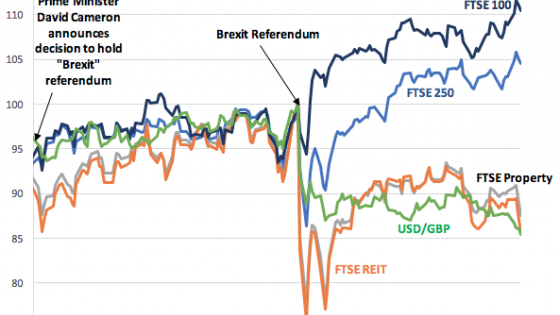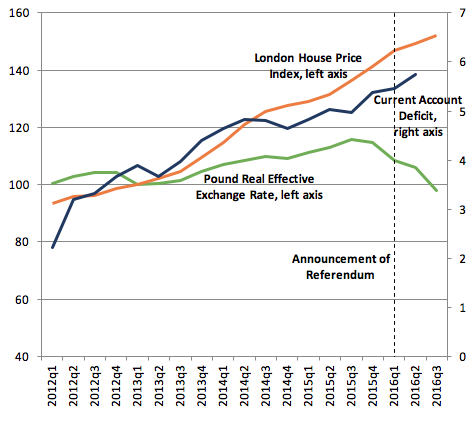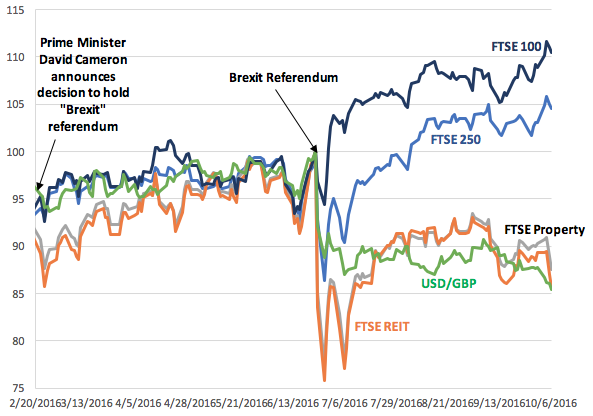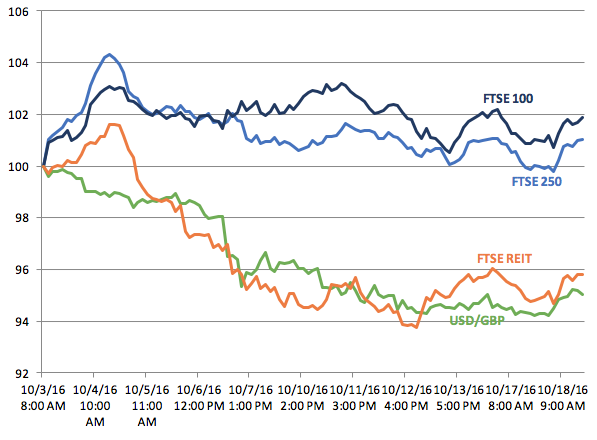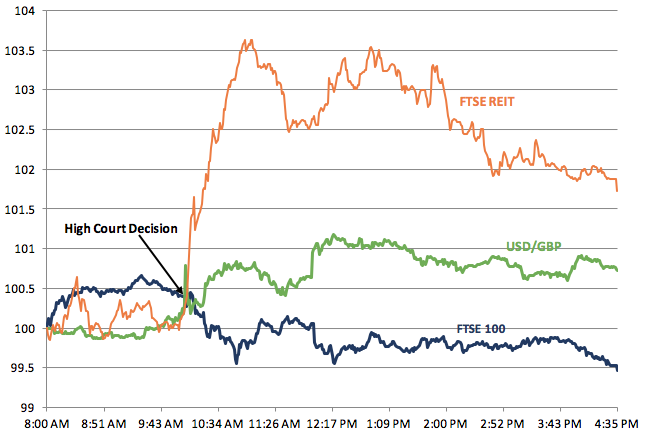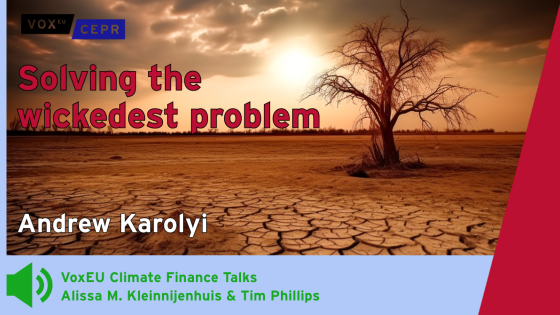Starting in 2012, once the financial crisis had been left well behind and fiscal austerity had been eased, a renewed property-buying frenzy started in London and neighbouring regions, as Figure 1 shows. Believing that property prices would continue to rise, even Russian oligarchs and Indian billionaires thought the craziness was a safe investment. The speculative capital inflows caused the pound to appreciate. The exchange rate became overvalued, which hurt exports and drove up the current account deficit.
Figure 1 Pound carry-trade bubble
The 'carry trade' worked through property prices and the exchange rate feeding off each other. As London house prices appreciated, the expectation formed that prices would keep appreciating. After increasing about 6% in 2012, London house prices rose by between 12% and 15% a year for the next three years. The expectation that price increases would continue attracted speculative foreign capital, which bid up the value of the pound. Foreign speculators stood to gain twice, from both rising property prices and an appreciating pound. Presumably, they understood that the party could not go on forever. But, as in speculative bubbles, each investor believed that he or she could reverse the trades before the collapse began.
The phenomenon of an appreciating exchange rate and larger capital inflows has been widely observed in other contexts. Bruno and Shin (2015a) found this correlation in a sample of 46 countries between 1996 and 2010. Although the appreciating currency makes the country less competitive, and hence less able to pay back its debts to foreigners, the currency continues to appreciate in the expectation of short-term capital gains. The same logic applied to Britain. Property with rising values offered the possibility of capital gains, which attracted foreign capital, which bid up the pound. Britain lost competitiveness, the current account deficit widened, and so the process kept going.
Clearly, carry trade is a fragile phenomenon. It was sustained in Britain by the belief that property was a safe asset. The Bank of England’s chief economist, Andy Haldane, has commented that households seeking financial safety would do better to invest in property rather than rely on pensions (Guardian 2016). London, with its unrivalled status as Europe’s financial hub, was considered particularly safe.
But once the Brexit referendum became imminent, the pace of house price increases fell, coming down to an annual 7% rate of increase in the second and third quarters of 2016. After the referendum, the slowdown in rate of property price increase has been accompanied by the expectation that property prices will actually fall.
All asset prices fell sharply after the referendum vote for Brexit on 23 June 2016 (Figure 2). But because the FTSE 100 and FTSE 250 quickly moved back to levels higher than before the referendum, media commentary and popular attention became focused on the continued decline in the US dollar value of the British pound (USD/GBP). An important accompanying development, however, went unnoted. The weakness of the pound was strikingly correlated with similar weakness of property-related asset prices (the FTSE property index and the Real Estate Investment Trust (REIT) index). Just as the pound remained well below its pre-Brexit levels, so did prospects for property values.
The decline in expected property prices was mirrored in frantic withdrawal from property funds. In contrast, 'real' economic metrics held up well. GDP growth and employment have performed better than immediate pre-referendum predictions, and better even than forecasts from early 2016 that had discounted Brexit.
Figure 2 Daily movements: Stock prices, property price expectations, and the pound
The pattern observed between 23 June and early October was reinforced after the Conservative party conference began on 2 October. In the days that followed, news suggested the government would seek a 'hard Brexit', which implied that Britain’s role as Europe’s financial centre would be undermined. This had obvious implications for the City of London, and London property prices. The post-Brexit referendum trend was reinforced. At an hourly frequency, we can see that expected property prices and the pound fell further while the FTSE100 and FTSE250 held up (Figure 3). The movements did not match every hour – instead, property price and pound indices play 'catch-up' with each other.
Figure 3 Hourly asset price movements following the start of the Conservative Party conference on 2 October 2016
A final, even higher frequency piece of evidence reinforces the link between property prices and the pound. Just after 10am on 3 November 2016, the High Court ruled that the government did not have the power to trigger Article 50 to begin the process of leaving the EU without consulting Parliament. The Court’s decision was interpreted as likely to delay or even dilute the degree to which the UK would actually leave the EU. In the hour after the decision was announced, the value of the pound rose, as did the REIT index. Presumably, the inference was that London’s status as a financial centre, and the safety of property prices, may be partially restored. In contrast, the FTSE 100 fell sharply, suggesting that the rising pound would once again hurt British competitiveness. For the rest of 3 November, the pound and REIT continued to move together, while the FTSE 100 moved largely in the opposite direction. Overall, however, the rise in the pound and property price expectations was minor and likely to remain so if Brexit continues at a slower pace.
Figure 4 Price movements after the 3 November 2016 High Court decision requiring parliamentary approval for Brexit
Brexit broke the spell
The post-Brexit referendum movements in asset prices tell a consistent story. Whether over the months since the referendum, or in the days after the Conservative Party conference, property price expectations and the pound fell in tandem, suggesting that the pound’s carry trade bubble from 2012-2015 was unwinding. Stock prices, in contrast, rose and remained above pre-referendum levels. The implication is that some part of the lost competitiveness was being regained.
The High Court decision amended the narrative: Brexit may not be so 'hard' after all. The rise in property price expectations and the pound that followed this decision implies that the perception of London property as a safe asset can recover if Brexit is diluted. If that did happen, the fall in stock prices that mirrored the strengthening of the pound also tells us that British competitiveness and growth prospects could be undermined.
Some have argued that Britain has been suffering from Dutch disease (Krugman 2016). Just as foreign capital has in the past been attracted to some countries to exploit the potential for commodity exports, causing the exchange rate to appreciate, so Britain’s financial sector pulled foreign capital, which pushed up the value of the pound. In the Dutch disease analysis, the sector that attracts foreign capital – the commodity or financial sector – also contributes to the country’s exports. London’s financial sector probably did cause Dutch disease, but the problem was more serious. A non-tradeable sector – property – was pulling in capital in the expectation of short-term capital gains, pushing up the pound’s value and undermining British competitiveness. Neither the financial bubble nor the continued loss of competitiveness could last. Brexit broke the spell.
Author’s note: I am grateful to Graham McKee for the data analysis and to Bobray Bordelon for help with assembling the data.
References
Bruno, V and H S Shin (2015a), “Cross-Border Banking and Global Liquidity,” Review of Economic Studies 82 (2): 535-564.
Bruno, V and H S Shin (2015b), “Capital Flows and the Risk-Taking Channel of Monetary Policy,” Journal of Monetary Economics 71: 119–132.
Guardian (2016), “’Property is better bet’ Than a Pension Says Bank of England Economist”, 30 August. .
Krugman, P (2016), “Notes on Brexit and the Pound”.
